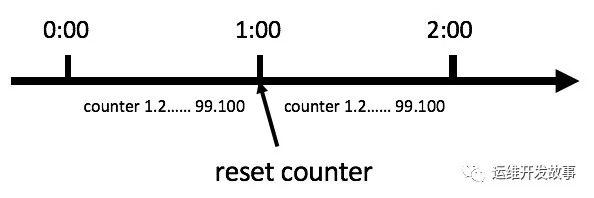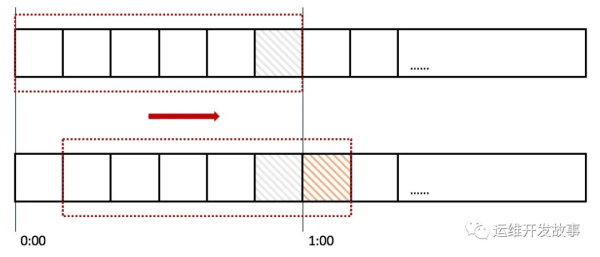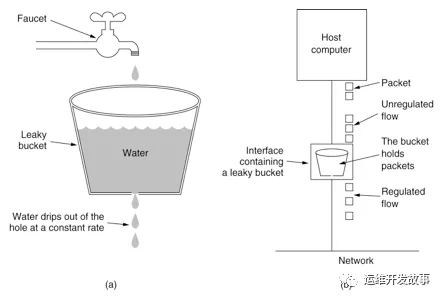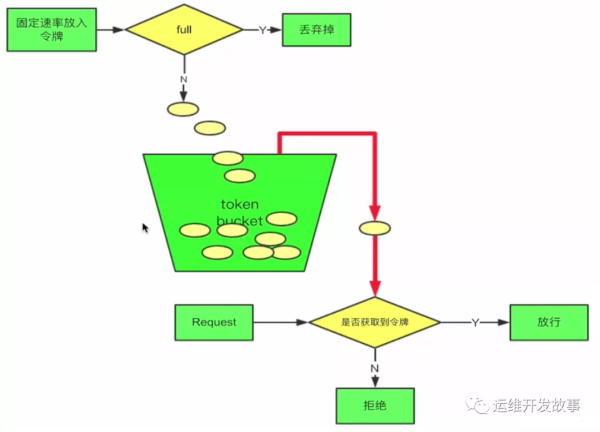这篇文章主要讲解了“Sentinel常用的流控算法有哪些”,文中的讲解内容简单清晰,易于学习与理解,下面请大家跟着小编的思路慢慢深入,一起来研究和学习“Sentinel常用的流控算法有哪些”吧!
本文主要讲述常见的几种限流算法:计数器算法、漏桶算法、令牌桶算法。然后结合我对 Sentinel 1.8.0 的理解,给大家分享 Sentinel 在源码中如何使用这些算法进行流控判断。
我们可以直接通过一个计数器,限制每一秒钟能够接收的请求数。比如说 qps定为 1000,那么实现思路就是从第一个请求进来开始计时,在接下去的 1s 内,每来一个请求,就把计数加 1,如果累加的数字达到了 1000,那么后续的请求就会被全部拒绝。等到 1s 结束后,把计数恢复成 0 ,重新开始计数。

优点:实现简单
缺点:如果1s 内的前半秒,已经通过了 1000 个请求,那后面的半秒只能请求拒绝,我们把这种现象称为“突刺现象”。
实现代码案例:
public class Counter { public long timeStamp = getNowTime(); public int reqCount = 0; public final int limit = 100; // 时间窗口内最大请求数 public final long interval = 1000; // 时间窗口ms public boolean limit() { long now = getNowTime(); if (now < timeStamp + interval) { // 在时间窗口内 reqCount++; // 判断当前时间窗口内是否超过最大请求控制数 return reqCount <= limit; } else { timeStamp = now; // 超时后重置 reqCount = 1; return true; } } public long getNowTime() { return System.currentTimeMillis(); } }滑动窗口,又称 Rolling Window。为了解决计数器算法的缺陷,我们引入了滑动窗口算法。下面这张图,很好地解释了滑动窗口算法:

在上图中,整个红色的矩形框表示一个时间窗口,在我们的例子中,一个时间窗口就是一分钟。然后我们将时间窗口进行划分,比如图中,我们就将滑动窗口 划成了6格,所以每格代表的是10秒钟。每过10秒钟,我们的时间窗口就会往右滑动一格。每一个格子都有自己独立的计数器counter,比如当一个请求 在0:35秒的时候到达,那么0:30~0:39对应的counter就会加1。
那么滑动窗口怎么解决刚才的临界问题的呢?我们可以看上图,0:59到达的100个请求会落在灰色的格子中,而1:00到达的请求会落在橘黄色的格子中。当时间到达1:00时,我们的窗口会往右移动一格,那么此时时间窗口内的总请求数量一共是200个,超过了限定的100个,所以此时能够检测出来触发了限流。
我再来回顾一下刚才的计数器算法,我们可以发现,计数器算法其实就是滑动窗口算法。只是它没有对时间窗口做进一步地划分,所以只有1格。
由此可见,当滑动窗口的格子划分的越多,那么滑动窗口的滚动就越平滑,限流的统计就会越精确。
实现代码案例:
public class SlideWindow { /** 队列id和队列的映射关系,队列里面存储的是每一次通过时候的时间戳,这样可以使得程序里有多个限流队列 */ private volatile static Map<String, List<Long>> MAP = new ConcurrentHashMap<>(); private SlideWindow() {} public static void main(String[] args) throws InterruptedException { while (true) { // 任意10秒内,只允许2次通过 System.out.println(LocalTime.now().toString() + SlideWindow.isGo("ListId", 2, 10000L)); // 睡眠0-10秒 Thread.sleep(1000 * new Random().nextInt(10)); } } /** * 滑动时间窗口限流算法 * 在指定时间窗口,指定限制次数内,是否允许通过 * * @param listId 队列id * @param count 限制次数 * @param timeWindow 时间窗口大小 * @return 是否允许通过 */ public static synchronized boolean isGo(String listId, int count, long timeWindow) { // 获取当前时间 long nowTime = System.currentTimeMillis(); // 根据队列id,取出对应的限流队列,若没有则创建 List<Long> list = MAP.computeIfAbsent(listId, k -> new LinkedList<>()); // 如果队列还没满,则允许通过,并添加当前时间戳到队列开始位置 if (list.size() < count) { list.add(0, nowTime); return true; } // 队列已满(达到限制次数),则获取队列中最早添加的时间戳 Long farTime = list.get(count - 1); // 用当前时间戳 减去 最早添加的时间戳 if (nowTime - farTime <= timeWindow) { // 若结果小于等于timeWindow,则说明在timeWindow内,通过的次数大于count // 不允许通过 return false; } else { // 若结果大于timeWindow,则说明在timeWindow内,通过的次数小于等于count // 允许通过,并删除最早添加的时间戳,将当前时间添加到队列开始位置 list.remove(count - 1); list.add(0, nowTime); return true; } } }在 Sentinel 中 通过 LeapArray 结构来实现时间窗算法, 它的核心代码如下(只列举获取时间窗方法):
/** * 获取当前的时间窗 * * Get bucket item at provided timestamp. * * @param timeMillis a valid timestamp in milliseconds * @return current bucket item at provided timestamp if the time is valid; null if time is invalid */ public WindowWrap<T> currentWindow(long timeMillis) { if (timeMillis < 0) { return null; } int idx = calculateTimeIdx(timeMillis); // Calculate current bucket start time. // 计算窗口的开始时间,计算每个格子的开始时间 long windowStart = calculateWindowStart(timeMillis); /* * Get bucket item at given time from the array. * * (1) Bucket is absent, then just create a new bucket and CAS update to circular array. * (2) Bucket is up-to-date, then just return the bucket. * (3) Bucket is deprecated, then reset current bucket and clean all deprecated buckets. */ while (true) { WindowWrap<T> old = array.get(idx); // 如果没有窗格,创建窗格 if (old == null) { /* * B0 B1 B2 NULL B4 * ||_______|_______|_______|_______|_______||___ * 200 400 600 800 1000 1200 timestamp * ^ * time=888 * bucket is empty, so create new and update * * If the old bucket is absent, then we create a new bucket at {@code windowStart}, * then try to update circular array via a CAS operation. Only one thread can * succeed to update, while other threads yield its time slice. */ WindowWrap<T> window = new WindowWrap<T>(windowLengthInMs, windowStart, newEmptyBucket(timeMillis)); if (array.compareAndSet(idx, null, window)) { // Successfully updated, return the created bucket. return window; } else { // Contention failed, the thread will yield its time slice to wait for bucket available. Thread.yield(); } // 当前窗格存在,返回历史窗格 } else if (windowStart == old.windowStart()) { /* * B0 B1 B2 B3 B4 * ||_______|_______|_______|_______|_______||___ * 200 400 600 800 1000 1200 timestamp * ^ * time=888 * startTime of Bucket 3: 800, so it's up-to-date * * If current {@code windowStart} is equal to the start timestamp of old bucket, * that means the time is within the bucket, so directly return the bucket. */ return old; // } else if (windowStart > old.windowStart()) { /* * (old) * B0 B1 B2 NULL B4 * |_______||_______|_______|_______|_______|_______||___ * ... 1200 1400 1600 1800 2000 2200 timestamp * ^ * time=1676 * startTime of Bucket 2: 400, deprecated, should be reset * * If the start timestamp of old bucket is behind provided time, that means * the bucket is deprecated. We have to reset the bucket to current {@code windowStart}. * Note that the reset and clean-up operations are hard to be atomic, * so we need a update lock to guarantee the correctness of bucket update. * * The update lock is conditional (tiny scope) and will take effect only when * bucket is deprecated, so in most cases it won't lead to performance loss. */ if (updateLock.tryLock()) { try { // Successfully get the update lock, now we reset the bucket. // 清空所有的窗格数据 return resetWindowTo(old, windowStart); } finally { updateLock.unlock(); } } else { // Contention failed, the thread will yield its time slice to wait for bucket available. Thread.yield(); } // 如果时钟回拨,重新创建时间格 } else if (windowStart < old.windowStart()) { // Should not go through here, as the provided time is already behind. return new WindowWrap<T>(windowLengthInMs, windowStart, newEmptyBucket(timeMillis)); } } }漏桶算法(Leaky Bucket)是网络世界中流量整形(Traffic Shaping)或速率限制(Rate Limiting)时经常使用的一种算法,它的主要目的是控制数据注入到网络的速率,平滑网络上的突发流量。漏桶算法提供了一种机制,通过它,突发流量可以被整形以便为网络提供一个稳定的流量, 执行过程如下图所示。

实现代码案例:
public class LeakyBucket { public long timeStamp = System.currentTimeMillis(); // 当前时间 public long capacity; // 桶的容量 public long rate; // 水漏出的速度 public long water; // 当前水量(当前累积请求数) public boolean grant() { long now = System.currentTimeMillis(); // 先执行漏水,计算剩余水量 water = Math.max(0, water - (now - timeStamp) * rate); timeStamp = now; if ((water + 1) < capacity) { // 尝试加水,并且水还未满 water += 1; return true; } else { // 水满,拒绝加水 return false; } } }说明:
(1)未满加水:通过代码 water +=1进行不停加水的动作。
(2)漏水:通过时间差来计算漏水量。
(3)剩余水量:总水量-漏水量。
在 Sentine 中RateLimiterController 实现了了漏桶算法 , 核心代码如下
@Override public boolean canPass(Node node, int acquireCount, boolean prioritized) { // Pass when acquire count is less or equal than 0. if (acquireCount <= 0) { return true; } // Reject when count is less or equal than 0. // Otherwise,the costTime will be max of long and waitTime will overflow in some cases. if (count <= 0) { return false; } long currentTime = TimeUtil.currentTimeMillis(); // Calculate the interval between every two requests. // 计算时间间隔 long costTime = Math.round(1.0 * (acquireCount) / count * 1000); // Expected pass time of this request. // 期望的执行时间 long expectedTime = costTime + latestPassedTime.get(); // 当前时间 > 期望时间 if (expectedTime <= currentTime) { // Contention may exist here, but it's okay. // 可以通过,并且设置最后通过时间 latestPassedTime.set(currentTime); return true; } else { // Calculate the time to wait. // 等待时间 = 期望时间 - 最后时间 - 当前时间 long waitTime = costTime + latestPassedTime.get() - TimeUtil.currentTimeMillis(); // 等待时间 > 最大排队时间 if (waitTime > maxQueueingTimeMs) { return false; } else { // 上次时间 + 间隔时间 long oldTime = latestPassedTime.addAndGet(costTime); try { // 等待时间 waitTime = oldTime - TimeUtil.currentTimeMillis(); // 等待时间 > 最大排队时间 if (waitTime > maxQueueingTimeMs) { latestPassedTime.addAndGet(-costTime); return false; } // in race condition waitTime may <= 0 // 休眠等待 if (waitTime > 0) { Thread.sleep(waitTime); } // 等待完了,就放行 return true; } catch (InterruptedException e) { } } } return false; }令牌桶算法是网络流量整形(Traffic Shaping)和速率限制(Rate Limiting)中最常使用的一种算法。典型情况下,令牌桶算法用来控制发送到网络上的数据的数目,并允许突发数据的发送。如下图所示:

简单的说就是,一边请求时会消耗桶内的令牌,另一边会以固定速率往桶内放令牌。当消耗的请求大于放入的速率时,进行相应的措施,比如等待,或者拒绝等。
实现代码案例:
public class TokenBucket { public long timeStamp = System.currentTimeMillis(); // 当前时间 public long capacity; // 桶的容量 public long rate; // 令牌放入速度 public long tokens; // 当前令牌数量 public boolean grant() { long now = System.currentTimeMillis(); // 先添加令牌 tokens = Math.min(capacity, tokens + (now - timeStamp) * rate); timeStamp = now; if (tokens < 1) { // 若不到1个令牌,则拒绝 return false; } else { // 还有令牌,领取令牌 tokens -= 1; return true; } } }Sentinel 在 WarmUpController 中运用到了令牌桶算法,在这里可以实现对系统的预热,设定预热时间和水位线,对于预热期间多余的请求直接拒绝掉。
public boolean canPass(Node node, int acquireCount, boolean prioritized) { long passQps = (long) node.passQps(); long previousQps = (long) node.previousPassQps(); syncToken(previousQps); // 开始计算它的斜率 // 如果进入了警戒线,开始调整他的qps long restToken = storedTokens.get(); if (restToken >= warningToken) { long aboveToken = restToken - warningToken; // 消耗的速度要比warning快,但是要比慢 // current interval = restToken*slope+1/count double warningQps = Math.nextUp(1.0 / (aboveToken * slope + 1.0 / count)); if (passQps + acquireCount <= warningQps) { return true; } } else { if (passQps + acquireCount <= count) { return true; } } return false; }时间窗算法的本质也是通过计数器算法实现的。
时间窗算法格子划分的越多,那么滑动窗口的滚动就越平滑,限流的统计就会越精确,但是也会占用更多的内存存储。
漏桶算法和令牌桶算法本质上是为了做流量整形或速率限制,避免系统因为大流量而被打崩,但是两者的核心差异在于限流的方向是相反的
漏桶:限制的是流量的流出速率,是相对固定的。
令牌桶 :限制的是流量的平均流入速率,并且允许一定程度的突然性流量,最大速率为桶的容量和生成token的速率。
在某些场景中,漏桶算法并不能有效的使用网络资源,因为漏桶的漏出速率是相对固定的,所以在网络情况比较好并且没有拥塞的状态下,漏桶依然是会有限制的,并不能放开量,因此并不能有效的利用网络资源。而令牌桶算法则不同,其在限制平均速率的同时,支持一定程度的突发流量。
感谢各位的阅读,以上就是“Sentinel常用的流控算法有哪些”的内容了,经过本文的学习后,相信大家对Sentinel常用的流控算法有哪些这一问题有了更深刻的体会,具体使用情况还需要大家实践验证。这里是亿速云,小编将为大家推送更多相关知识点的文章,欢迎关注!
免责声明:本站发布的内容(图片、视频和文字)以原创、转载和分享为主,文章观点不代表本网站立场,如果涉及侵权请联系站长邮箱:is@yisu.com进行举报,并提供相关证据,一经查实,将立刻删除涉嫌侵权内容。